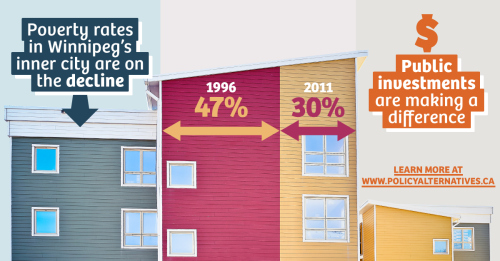rabble is expanding our Parliamentary Bureau and we need your help! Support us on Patreon today!
It has recently been claimed in the media that nothing is working in the fight against poverty.
The Canadian Centre for Policy Alternatives’ State of the Inner City Report 2015: Drawing on Our Strengths, shows that this is not the case. Important poverty-related indicators are improving. After decades of decline, public investment in community-led initiatives is making a difference.
Problems remain. Poverty is deeply rooted, spatially concentrated, complex, often racialized and not quickly solved. It damages and in some cases ruins the lives of those who are poor. We all pay the price for this.
In her chapter in the State of the Inner City Report 2015, Keely Ten Fingers describes the results of focus groups with 46 Indigenous and newcomer young people about their experiences with employment. These young people are keen to find good jobs, but systemic barriers get in the way. They shared painful experiences of racism and discrimination, along with struggles to meet basic needs for themselves and their families. Available jobs are too often poorly paid and lack benefits, job security, union protections and opportunities for advancement. What helps, they say, are school-based programs, community-based organizations and supportive work environments that facilitate the transition to employment. Ten Fingers’ chapter is just one of many examples of the challenges that remain in combatting poverty.
But a key aspect of the State of the Inner City Report 2015 is that, without denying that poverty continues to be far too high, gains are nevertheless being made, as revealed by Statistics Canada and National Household Survey data showing trends in the inner city from 1996 to 2011.
For example, the long period of inner-city population decline that began in the 1960s bottomed out in 2001 and has grown since. Between 2006 and 2011 population grew in 31 of 39 inner-city neighbourhoods, suggesting that conditions are improving and people are choosing to stay.
Education levels in the inner city are improving. In 1996, 44 per cent of inner-city adults had not completed grade 12; by 2011, that proportion had dropped to 20 per cent.
The unemployment rate outside the inner city declined by 2.1 percentage points between 1996 and 2011, while in the inner city it declined by 7.1 percentage points. And although still high, the unemployment rate for Aboriginal people in the inner city declined by 21 percentage points between 1996 and 2006, and another 2 percentage points to 2011.
The same trend can be seen for household incomes: while still much lower in the inner city than in the rest of Winnipeg, inner-city incomes are rising faster — in fact, 2.5 times faster in the inner city than the rest of Winnipeg.
Poverty rates, as measured by the before-tax low-income cut-off (LICO), are also declining faster in the inner city — the proportion of people with incomes below the LICO has declined 10 percentage points more in the inner city than in the rest of Winnipeg.
What accounts for these gains? The improvements between 1996 and 2011 have occurred during a time when public investments have been made in community-led initiatives. For example, the provincial government’s Neighbourhoods Alive! (NA!) program, in place since 2000, promotes a form of community-led development that engages inner-city residents in promoting housing, safety, youth-oriented and greening initiatives that appear to be having a steady, cumulative effect. NA! also provides core funding to Neighbourhood Renewal Corporations, which are community-based organizations that coordinate and facilitate many of these initiatives, and that are highly effective. While such gains cannot definitively be linked to specific causes, the evidence strongly suggests that public investment in community-led initiatives is the explanation.
The provincial government, along with public bodies like the Winnipeg Foundation and United Way of Winnipeg, has made significant investments in social housing, alternative education initiatives and social enterprises that transition those with multiple barriers into the paid labour force. More recently the Province has introduced Rent Assist, a program that is cutting edge in social policy and that moves Manitoba toward a guaranteed annual income.
Poverty has not been defeated. It is still far too high, in the inner city as elsewhere. As Keely Ten Fingers shows, too many barriers, including racism, still stand in the way of Indigenous and newcomer young people securing good jobs that will pull them and their families out of poverty.
But we are making gains. It is simply not true that nothing is working.
Because poverty in Winnipeg’s inner city is deep and complex, gains are a gradual and cumulative process, the result of consistent public investment in community-led initiatives over time. It is this consistency that is crucial.
It is important to be able to show that gains are being made. The claim that nothing is working runs the risk of leading people to throw their hands up in despair, and to say that there is no point in investing tax dollars in low-income communities.
That would be a mistake. Slow and labourious though this cumulative process is, we have made tangible gains between 1996 and 2011. If we had data for 2015, it is likely that they would show still further gains. If we persist, and even better if we accelerate public investment in community-led initiatives and community-based organizations, we will make still more gains.
Given the data, why would we do otherwise?
This blog post was first published in the Winnipeg Free Press Dec 10, 2015. Jim Silver is Chair of the University of Winnipeg’s Department of Urban and Inner-City Studies, which is located on Selkirk Avenue in Winnipeg’s North End. He is a Research Associate with the Canadian Centre for Policy Alternatives-Manitoba.
rabble is expanding our Parliamentary Bureau and we need your help! Support us on Patreon today!



